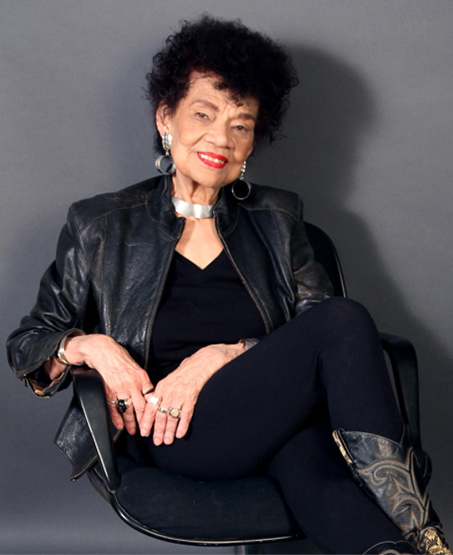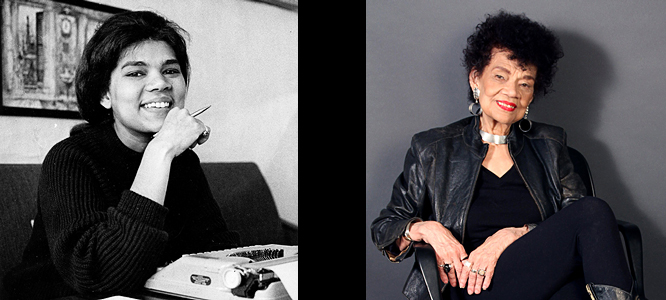

About
BRIEF BIO
Lorraine O’Grady is a conceptual artist and cultural critic whose work over four decades has employed the diptych, or at least the diptych idea, as its primary form. While she has consistently addressed issues of diaspora, hybridity and black female subjectivity and has emphasized the formative roles these have played in the history of modernism, O’Grady also uses the diptych’s “both/and thinking” to frame her themes as symptoms of a larger problematic, that of the divisive and hierarchical either/or categories underpinning Western philosophy. In O’Grady’s works across various genres including text, photo-installation, video and performance, multiple emotions and ideas coexist. Personal and aesthetic attitudes often considered contradictory, such as anger and joy or classicism and surrealism, are not distinguished. Even technical means seem governed by both chance and obsessive control so as to express political argument and unapologetic beauty simultaneously. And across the whole, essays and images interpenetrate. While O’Grady’s diptychs are sometimes explicit, with two images side by side, at other times they are implicit, as when two types of hair—silk and tumbleweed, videotaped on the same scalp at different hours of the same day—alternate and interact to create permeating worlds. The goal of her diptychs is not to bring about a mythic “reconciliation of opposites,” but rather to enable or even force a conversation between dissimilars long enough to induce familiarity. For O’Grady, the diptych helps to image the kind of “both/and” or “miscegenated” thinking that may be needed to counter and destabilize the West’s either/or binary of “winners or losers,” one that is continuously birthing supremacies, from the intimate to the political, of which white supremacy may be only the most all-inclusive.
An early adopter of digital technology, O’Grady has also created a website, lorraineogrady.com, which is considered a model of the online abbreviated-archive, and her paper archive is in the collection of the Wellesley College Library. Among O’Grady’s writings, the 1992/94 long-form essay “Olympia’s Maid: Reclaiming Black Female Subjectivity” has proved an enduring contribution to the fields of art history and intersectional feminism and is now considered canonical. O’Grady’s art works have been acquired by, among other institutions, the Art Institute of Chicago. IL; Museum of Modern Art, NY; Tate Modern, London, UK; Museum of Fine Arts, Boston, MA; and the Whitney Museum of American Art, NY.
Brief Bio
Lorraine O’Grady is a conceptual artist and cultural critic whose work over four decades has employed the diptych, or at least the diptych idea, as its primary form. While she has consistently addressed issues of diaspora, hybridity and black female subjectivity and has emphasized the formative roles these have played in the history of modernism, O’Grady also uses the diptych’s “both/and thinking” to frame her themes as symptoms of a larger problematic, that of the divisive and hierarchical either/or categories underpinning Western philosophy. In O’Grady’s works across various genres including text, photo-installation, video and performance, multiple emotions and ideas coexist. Personal and aesthetic attitudes often considered contradictory, such as anger and joy or classicism and surrealism, are not distinguished. Even technical means seem governed by both chance and obsessive control so as to express political argument and unapologetic beauty simultaneously. And across the whole, essays and images interpenetrate. While O’Grady’s diptychs are sometimes explicit, with two images side by side, at other times they are implicit, as when two types of hair—silk and tumbleweed, videotaped on the same scalp at different hours of the same day—alternate and interact to create permeating worlds. The goal of her diptychs is not to bring about a mythic “reconciliation of opposites,” but rather to enable or even force a conversation between dissimilars long enough to induce familiarity. For O’Grady, the diptych helps to image the kind of “both/and” or “miscegenated” thinking that may be needed to counter and destabilize the West’s either/or binary of “winners or losers,” one that is continuously birthing supremacies, from the intimate to the political, of which white supremacy may be only the most all-inclusive.
An early adopter of digital technology, O’Grady has also created a website, lorraineogrady.com, which is considered a model of the online abbreviated-archive, and her paper archive is in the collection of the Wellesley College Library. Among O’Grady’s writings, the 1992/94 long-form essay “Olympia’s Maid: Reclaiming Black Female Subjectivity” has proved an enduring contribution to the fields of art history and intersectional feminism and is now considered canonical. O’Grady’s art works have been acquired by, among other institutions, the Art Institute of Chicago. IL; Museum of Modern Art, NY; Tate Modern, London, UK; Museum of Fine Arts, Boston, MA; and the Whitney Museum of American Art, NY.
Work Experience Bio
MY JOB HISTORY
(a feminist “retrospective”)
© Lorraine O’Grady 2004
IT BEGAN as an interview for a student paper. . . .
Thu, Sep 23, 2004 16:42
Hey Grama Rain
For my Labor study: Women and Work, I have to interview 3-5 of my female family members and write a report on each, and I would like you to be one of them. These are the questions:
~What kinds of paid jobs have you held, approximately how old were you when you held them and what work did they entail? (in school and as an adult)
~What concerns if any, did you have in any of these jobs about working conditions, wages, benefits, hours, relationship to family responsibilities, sexual harassment, etc.?
~Was there any resistance within your family to you holding any of the jobs?
~Why did you choose these jobs?
Thanks so much. If you don’t have the time to answer the questions its ok i know your a busy lady, but i would be so grateful if you did. My paper is due the 30th next week so i need it before then. Thanks again
C.
Thu, Sep 23, 2004 21:33
Wow, C., that’s a tall order. You have no idea how many jobs I’ve had! I’ll do my best to get it to you by late Monday.
Grama Rain
Sun, Sep 26, 2004 23:16
Hey, C.,
I finished it a little early. It’s almost 9 single-spaced pages and only takes me up to 1972 (with a couple of flash-forwards to about 1990). I enjoyed writing it, and I even learned a few things. I didn’t specifically answer your questions, I had to ground them in the overall picture. But somewhere in there, I’m sure you’ll find stuff you can use for your paper. Hope you get a good grade!
Grama Rain
Mon, Sep 27, 2004 8:12
Thank you soooooo much! Wow that’s a lot of info. I better get started. I’ll let you know how i do.
C.
————————————————–
IN THE END, C. forgot to tell me her grade. I only recently learned that she’d received an A.
As for me, I ran out of time and energy at about 1972. I did a few flash-forwards but didn’t mention being a rock critic, and hardly discussed being an artist. One of these days, I’ll put down the whole story….
————————————————–
My First Job
When I started college in 1951, I was going to major in History. But after a course in Central European history, I knew I’d never be able to read fast enough. I couldn’t stop sub-vocalizing! So I decided to major in Spanish Literature. But after I got married and had a baby, I realized I would have to get practical. So I switched to Economics because I thought that would give me better job prospects. In my senior year, I went on a few interviews through the Career Center at Wellesley. But they weren’t too interesting. In those days, it seemed like the majority of recruiters, even at a high prestige women’s college like Wellesley, were fashion retailers. I went through the motions. I got dressed up, took the train to New York and talked with the people at Bergdorf’s and Alexander’s (opposite ends of the fashion scale). But it was clear, women retail buyers could only go so high. You would spend most of your life in dreary back rooms on the store floors, talking to low-level vendors with carpet fleas biting your legs.
That’s when I decided my training and interests were best suited for work in the government. It was the only “equal opportunity” employer at the time and, amazingly, it paid better than any of the other jobs. You took an exam and if you passed, you were in, even if you were a black female. This was 1956, and at that time, the Federal Government had an elite entry program called the (. . . .)
Long-Form Research CV
Download full PDF — A complete resumé. Contains full bibliographic citations. plus links to all materials available online. Bibliographic information for all items in the WRITING and PRESS Menus can be found here.
LORRAINE O’GRADY
Born September 21, 1934, Boston, MA.
Based in New York, NY.
Gallery:
Mariane Ibrahim Gallery
Chicago | Paris | Mexico City
https://marianeibrahim.com/artists/87-lorraine-ogrady/biography/
info@marianeibrahim.com
Archive:
Wellesley College Library, Wellesley, MA
Lorraine O’Grady Papers, 1952-2012
Finding Aids:
HTML: http://academics.wellesley.edu/lts/archives/MSS.3.html
PDF: http://www.wellesley.edu/sites/default/files/assets/departments/libraryandtechnology/files/archives/mss.3.pdf
Education
1951 H.S., Girls Latin School, Boston, MA. Honors in English and Latin, First Place in History. National Honor Society.
1956 B.A., Wellesley College, Wellesley, MA. Major: Economics. Minor: Spanish Literature. Freshman Honors.
1965-67 M.F.A. Candidate, Iowa Writers Workshop, University of Iowa, Iowa City, IA. Fiction.
Performances
1979-80 The Dual Soul—Part 1: Divine Twins; Part 2: Come Into Me, You. Written for performance-artist protagonist (…)
1980 Rosie O’Grady’s Pub, NYC. Sweet Rosie O’Grady. Private guerrilla performance.
1980 Just Above Midtown Gallery, NYC. Mlle Bourgeoise Noire Goes to JAM. Guerrilla performance.
1980 Just Above Midtown Gallery, NYC. Nefertiti/Devonia Evangeline. Director: Linda Goode-Bryant.
1981 Elizabeth Irwin High School, NYC. Nefertiti/Devonia Evangeline. In “Acting Out: The First Political Performance Art Series.” (…)
1981 Just Above Midtown Gallery, NYC. Gaunt Gloves. Performance and lecture by Mlle Bourgeoise Noire.
1981 New Museum for Contemporary Art, NYC. Mlle Bourgeoise Noire Goes to the New Museum. Guerrilla performance.
1981 Feminist Art Institute, NYC. Nefertiti/Devonia Evangeline.
1982 Allen Memorial Art Museum, Oberlin College, Oberlin, OH. Nefertiti/Devonia Evangeline. Curator: William Olander.
1982 Central Park, NYC. Rivers, First Draft. In “Art Across the Park.” Curators: Gilbert Coker and Horace Brockington.
1983 Franklin Furnace, NYC. Fly By Night.
1983 Afro-American Day Parade, Harlem, USA. Art Is…. A Mlle Bourgeoise Noire event. Funded by New York State Council on the Arts.
1989 Maryland Institute College of Art, Baltimore, MD. Nefertiti/Devonia Evangeline. [Last performance of this work]
(…)
Condensed CV
Download full PDF — Resumé with selected links and categories.
Education
1955 B.A., Wellesley College. Economics–Spanish Literature
1965-67 M.F.A. Candidate, Iowa Writers Workshop, University of Iowa. Fiction.
Select Individual Exhibitions
2016 Centro Andaluz de Arte Contemporáneo, Sevilla, ES. Lorraine O’Grady.
2015 Carpenter Center, Harvard University, Cambridge, MA. Lorraine O’Grady: Where Margins Become Centers.
2015 Studio Museum in Harlem, NY. Lorraine O’Grady: Art Is….
2015 Alexander Gray Associates, NY. Lorraine O’Grady.
2012 Alexander Gray Associates, NY. Lorraine O’Grady: New Worlds.
2011 Goodman Gallery, Johannesburg, SA. Rose O’Grady, with Tracey Rose.
2010 Museum of Contemporary Art, Denver, CO. Miscegenated Family Album.
2008 Art Institute of Chicago, Permanent Collection, Miscegenated Family Album.
2007 Artpace, San Antonio, TX. Video installation: Persistent.
1999 Galerie Fotohof, Salzburg, Austria. Lorraine O’Grady/New Histories.
1995 Wadsworth Atheneum, Hartford, CT. Lorraine O’Grady/Matrix 127.
1993 Thomas Erben Gallery, NY. Lorraine O’Grady: Photo Images 1980-91
1991 INTAR Gallery, NYC. Lorraine O’Grady: Critical Interventions / Photomontages.
Select Group Exhibitions
2015 Palazzo Reale, Milan, IT. “La Grande Madre.” Fondazione Nicola Trussardi.
2014 CAC, New Orleans. En Mas’: Carnival and Performance Art of the Caribbean.
2014 Cartagena de Indias, Colombia. 1a Bienal Internacional de Arte Contemporáneo.
2013 Grey NYU / Studio Museum, NY. Radical Presence: Black Performance in Contemporary Art
2013 Whitney Museum of American Art, NY. Blues for Smoke.
2013 LACMA. Ends / Exits: Art from the Collections of LACMA and The Broad Fdtn.
2012 Mathaf: Arab Museum of Modern Art, Doha, Qatar. Tea with Nefertiti:
2012 Museum of Contemporary Art, Los Angeles, CA. Blues for Smoke.
2012 Davis Museum. A Generous Medium: Photography at Wellesley 1972-2012.
2012 Palais de Tokyo, Paris. La Triennale Paris, 2012: Intense Proximity.
(…)
In 2016, Anohni, fka Antony Hegarty of Antony and the Johnsons, made her first album in 6 years, the first under her new name, and one that marked a radically changed direction from chamber pop to political electronica, The critically acclaimed Hopelessness uses seductive dance beats to sound an alarm against the direction of an American-dominated global system. In its bold lyrics, society’s multiple ills—misogyny, racism, corporate greed, etc.—are equal threads in a single shroud: ecocide. The promotional tour featured 25’ tall video clips, with each track lip-synched by an individual woman, most in head-and-shoulder closeup. Videos from the tour performance have been uploaded to YouTube as individual songs. O’Grady lip-synchs “Marrow,” the last track on the album CD.
A review of O’Grady’s performance on “Marrow” was published on Hyperallergic by Jillian Steinhauer:http://hyperallergic.com/343253/lorraine-ogrady-stars-in-a-new-music-video-by-anohni/
October 17, 2011. At a panel on “Wellesley in the Arts,” at the Lower Manhattan Cultural Council, NYC, O’Grady described the effect of her Wellesley education on her art making and what she had to strip away to become “Mlle Bourgeoise Noire,” her guerrilla art persona in the early 1980’s.
April 25, 2012. During “Portrait of the Artist: Lorraine O’Grady” at the Performa Institute, NYU, in conversation with the art historian Kellie Jones, O’Grady discussed her work as a conceptual and performance artist and spoke of the two men whose lives and philosophies she’d compared in her photo-installation “The First and the Last of the Modernists,” in the 2010 Whitney Biennial.
In 2017, O’Grady was one of the 3 annual recipients of the Wellesley Alumnae Achievement Award since the Awards began in 1948, joining such previous winners as: Madeleine Korbel Albright, JudyAnn Bigby, Hillary Rodham Clinton, Nora Ephron, Maria Morris Hambourg, Carolyn G. Heilbrun, Amalya L. Kearse, Pamela Melroy, Barbara Scott Preiskel, Santha Rama Rau, Diane Sawyer, Leticia Ramos Shahani, Lynn Sherr, Alvia Wardlaw, Patricia J. Williams, and Shirley Young.
THE FEMINIST AVANT-GARDE OF THE 1970s

“Mlle Bourgeoise Noire Beats Herself with The-Whip-That-Made-Plantations-Move,” from Mlle Bourgeoise Noire Goes to the New Museum, 1981.
October 7, 2016-January 7, 2017. The Photographers’ Gallery, London. Works from the Verbund Collection, Vienna. Co-curated by: Gabriele Schor (Sammlung Verbund) and Anna Dannemann (The Photographers’ Gallery). Exhibition travels, 2016-18, to: Museum of Modern Art, Vienna, Austria; Centre for Art and Media, Karlsruhe, Germany; The Brno House of Arts, Brno, Czech Republic; and Stavanger Art Museum, Stavanger, Norway. From the Press Release: “An expansive exhibition comprising forty-eight international female artists and over 150 major works from the Verbund Collection in Vienna. The exhibition highlights groundbreaking practices that shaped the feminist art movement and provides a timely reminder of the wide impact of a seminal generation of artists.” In addition to well-known artists such as Valie Export, Suzanne Lacy, Martha Rosler, Cindy Sherman, and Francesca Woodman, there are such less familiar but impressively influential artists as Sanja Ivekovic, Birgit Jürgenssen and Nil Yalter. Earlier exhibits of feminist avant-garde works from the Sammlung Verbund featured 29 artists. The collection has since grown and now includes, among others, Judith Bernstein, Katalin Ladik, and Lorraine O’Grady.
Press Release—http://www.frieze.com/article/feminism-then-and-now
CENTRO ANDALUZ DE ARTE CONTEMPORANEO, SEVILLA, SP
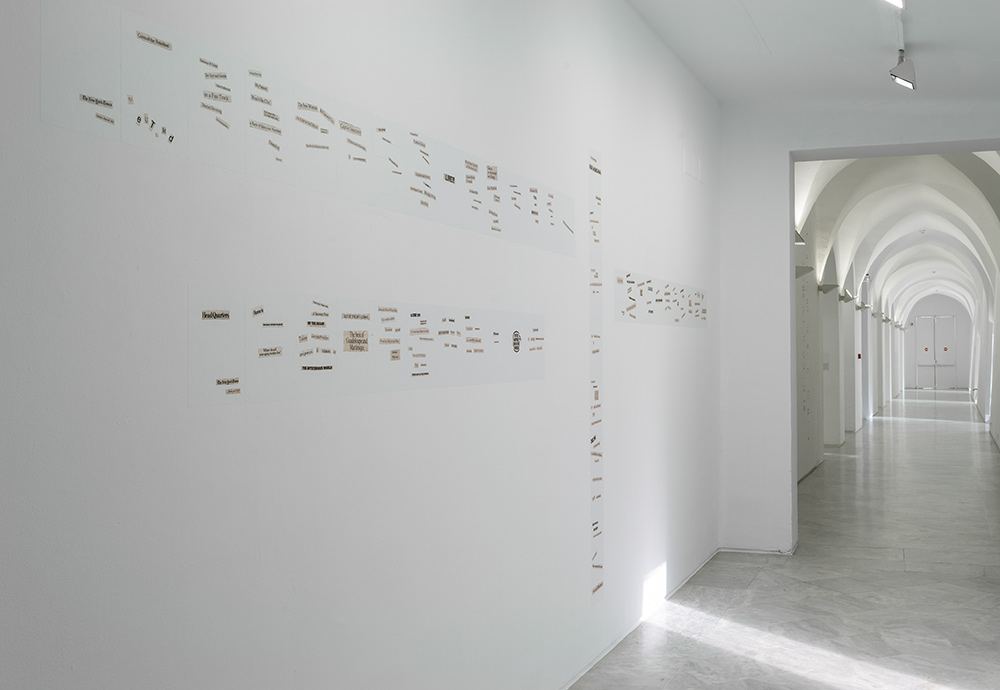
Cutting Out the New York Times (1977): six months, 26 poems.
September 15, 2016-January 15, 2017. Aproximación Inicial: Lorraine O’Grady | Initial Recognition: Lorraine O’Grady. Curators: Berta Sichel and Barbara Krulik. Fully occupying the CAAC’s main exhibition space in La Cartuja (the Carthusian Monastery), the exhibition is an extensive survey of O’Grady’s work to date, including full installations of Cutting Out the New York Times (1977), Mlle Bourgeoise Noire (1980-83/2009), Miscegenated Family Album (1980/94), Art Is… (1983/2009), and The First and the Last of the Modernists (2010), as well as images from Body Is the Ground of My Experience (1991/2012), including “The Clearing: or Cortes and La Malinche, Thomas Jefferson and Sally Hemings, N. and Me” and “The Fir-Palm,” plus room installations of O’Grady’s 18-minute video work Landscape (Western Hemisphere), (2010/11) and Adam Pendleton’s video study, Lorraine O’Grady: A Portrait, now subtitled in Spanish. Catalogue.
An evocative and effective overview of the exhibit — with Spanish narration and ‘Grady’s responses in English —was produced by Canal Sur (Andalucian TV). This 4 1/2- minute feature video may be found at:http://www.youtube.com/watch?v=_QabY8Bzy_k
Additional photos and videos may be seen on the blog of Erika Tamaura, Sonora, Mexico:http://erikatamaura.com/2016/09/21/lorraine-ogrady-aproximacion-inicial-caac_sevilla-sevilla/
For information (in English) on the Lorraine O’Grady’s exhibition at the Centro Andaluz de Arte Contemporáneo (CAAC), Sevilla, visit: http://www.caac.es/english/exh/projects/frame_log16.htm
LORRAINE O’GRADY: ASK ME ANYTHING ABOUT AGING
Lorraine O’Grady, 2014. Photo by Elia Alba for “The Supper Club” project, NY.
August 4, 2016, New Museum of Contemporary Art, NY. Conversation performance in the New Museum Theater, August 4, 2016. For Simone Leigh: The Waiting Room, New Museum for Contemporary Art, NY, a three-month residency project and exhibition countering the perception of holistic care as a luxury good through tactics of disobedience, social justice activism, and inter-generational sharing of wellness knowledge among women.
For further information on Simone Leigh: The Waiting Room, visit: http://www.newmuseum.org/exhibitions/view/simone-leigh-the-waiting-room
For more on O’Grady, “Ask Me Anything About Aging,” see: http://www.newmuseum.org/calendar/view/717/simone-leigh-the-waiting-room-lorraine-o-grady-ask-me-anything-about-aging
BLACKNESS IN ABSTRACTION: BY ADRIENNE EDWARDS
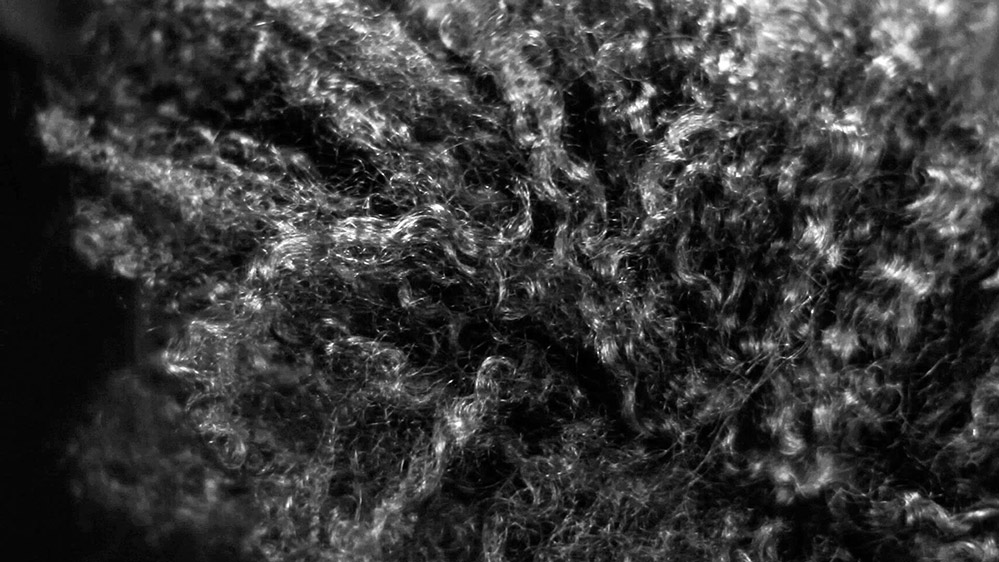
Video still from Lorraine O’Grady, Landscape (Western Hemisphere), 2010/11. 18 minutes.
June 24-August 19, 2016, Pace Gallery, NY. A select group of 29 artists, including Sol Lewitt, Louise Nevelson, Jack Whitten, Wangechi Mutu, and Adam Pendleton, display a dazzling variety of approaches both to the color black and to the concept of abstraction. Catalogue.
For more information, visit: http://www.pacegallery.com/exhibitions/12802/blackness-in-abstraction
Lorraine O’Grady: Where Margins Become Centers

Oct 29, 2015–Jan 10, 2016. With a boldly minimalist hanging, Harvard’s Carpenter Center for the Visual Arts, housed in LeCorbusier’s only building in the western hemisphere, is the first exhibit to effectively shift attention to O’Grady’s wall works as opposed to her earlier performances. The reviewer for the Boston Globe notes: “In those early performances, O’Grady brought the attention of a hermetic white art world to black art and the history of blacks in America. Work that followed grew more precise and more searing.”
For exhibition page, including links to online brochure and photo documentation, visit: http://carpenter.center/program/lorraine-o-grady-where-margins-become-centers
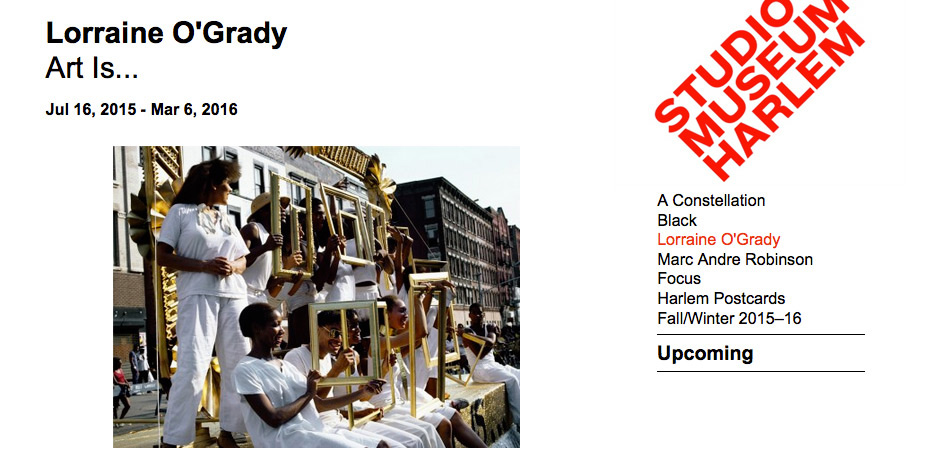 Jul 16, 2015–Mar 6, 2016. The Studio Museum in Harlem’s exhibit, Lorraine O’Grady: Art Is…. has been extended. Originally scheduled to close on October 25, it will be held over until March 6, according to an early press release, “in response to ongoing public enthusiasm.” The independent 40-piece installation O’Grady created from the almost 400 photos she collected of her 1983 eponymous performance in Harlem’s African-American Day Parade provides a full emotional experience of the earlier event, while layering intellectual comment on the exclusion of African Americans from that era’s avant-garde with a glimpse of what has been lost and gained since then. More than one reviewer has said it is worth a trip to the Museum to see this unique record of another time.
Jul 16, 2015–Mar 6, 2016. The Studio Museum in Harlem’s exhibit, Lorraine O’Grady: Art Is…. has been extended. Originally scheduled to close on October 25, it will be held over until March 6, according to an early press release, “in response to ongoing public enthusiasm.” The independent 40-piece installation O’Grady created from the almost 400 photos she collected of her 1983 eponymous performance in Harlem’s African-American Day Parade provides a full emotional experience of the earlier event, while layering intellectual comment on the exclusion of African Americans from that era’s avant-garde with a glimpse of what has been lost and gained since then. More than one reviewer has said it is worth a trip to the Museum to see this unique record of another time.
For more information visit: http://www.studiomuseum.org/exhibition/lorraine-ogrady-art
ALEXANDER GRAY ASSOCIATES, NY: LORRAINE O’GRADY
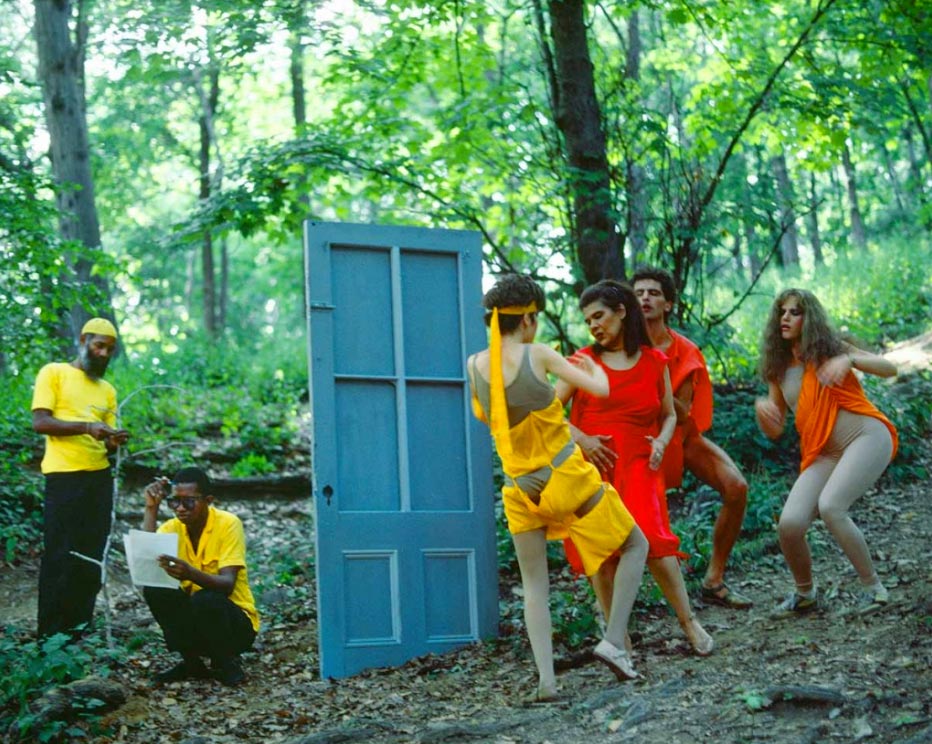
Rivers First Draft: The Debauchees intersect the Woman in Red, and the rape begins (1982/2015)
May 28-June 27, 2015. In the Main Gallery, the first showing of the Rivers, First Draft installation: 48 C-prints from Kodachromes of the eponymous 1982 performance in Central Park, NY, and produced by Eastman Kodak in 2015. With its “crossroads” theme and Futurist-styled simultaneous action, the Rivers, First Draft performance, featuring the Woman in Red — a prequel to O’Grady’s Mlle Bourgeoise Noire avatar — was the artist’s most autobiographical and feminist piece and has remained a major source of motifs and ideas for her work. Downstairs, in Alexander Gray’s ground-floor gallery, Rivers was introduced by five collage-poems from Cutting Out the New York Times, 1977, the 26-poem series in which O’Grady replied to the Dada-Surrealist theory of the newspaper poem by rejecting its randomness, working instead to create private, counter-confessional poetry from the newspaper’s impersonal, public language.
For complete images and press release, plus reviews, exhibition guide, and online catalogue, visit: http://www.alexandergray.com/exhibitions/lorraine-o-grady3

